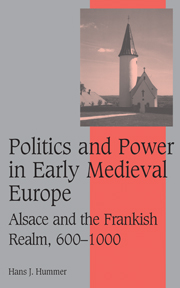Book contents
- Frontmatter
- Contents
- List of maps and tables
- Preface and acknowledgements
- List of abbreviations
- INTRODUCTION
- 1 THE LATE MEROVINGIAN ORDER
- 2 CONQUEST AND CONTINUITY
- 3 THE CAROLINGIANS AND ECCLESIASTICAL PROPERTY
- 4 REACTION AND RESISTANCE
- 5 THE POLITICS OF OLD GERMAN
- 6 IMPERIAL UNITY AND REGIONAL POWER
- 7 THE LATE CAROLINGIAN ORDER
- 8 THE TENTH-CENTURY TRANSFORMATION
- 9 CONCLUSIONS
- Appendix: Records of the dispute between Rodoin and Gebahart and the monastery of Weissenburg
- Bibliography
- Index
- Cambridge Studies in Medieval Life and Thought Fourth series
3 - THE CAROLINGIANS AND ECCLESIASTICAL PROPERTY
Published online by Cambridge University Press: 16 July 2009
- Frontmatter
- Contents
- List of maps and tables
- Preface and acknowledgements
- List of abbreviations
- INTRODUCTION
- 1 THE LATE MEROVINGIAN ORDER
- 2 CONQUEST AND CONTINUITY
- 3 THE CAROLINGIANS AND ECCLESIASTICAL PROPERTY
- 4 REACTION AND RESISTANCE
- 5 THE POLITICS OF OLD GERMAN
- 6 IMPERIAL UNITY AND REGIONAL POWER
- 7 THE LATE CAROLINGIAN ORDER
- 8 THE TENTH-CENTURY TRANSFORMATION
- 9 CONCLUSIONS
- Appendix: Records of the dispute between Rodoin and Gebahart and the monastery of Weissenburg
- Bibliography
- Index
- Cambridge Studies in Medieval Life and Thought Fourth series
Summary
Monasteries were not passive repositories of family property. As the self-styled ‘houses of God’ – organized according to a Rule, administered by a system of internal governance and set off by rites of passage which reminded members of their primary obedience to God and His representative, the abbot – they possessed a strong sense of their own institutional rights and responsibilities. Although patrons and monasteries usually cooperated with one another, relations could become disharmonious when perceptions of their respective obligations clashed. This tension was not induced by lay rapaciousness, clerical greed, the monks' fears of secular contamination or any other well-worn stereotypes of lay and ecclesiastical animosity. Such charges and complaints only emerged as major issues in the late tenth century. The source of the tension in the late eighth century rather was traceable to the place of monasteries in the Carolingian social and political order.
That ecclesiastical institutions constituted a crucial pillar of Carolingian power has long been recognized. Still to be explored is the precise relationship between the rise of the Carolingians, the Carolingians' use of ecclesiastical wealth, their consolidation of royal power in the eighth century and the effect of all these things on the networks of lordship tethered to monastic endowments. Although Carolingian lords generally respected the property rights of ecclesiastical institutions, and by extension those of patron families, they were quick to help themselves to the landed wealth accumulating in monasteries.
- Type
- Chapter
- Information
- Politics and Power in Early Medieval EuropeAlsace and the Frankish Realm, 600–1000, pp. 76 - 104Publisher: Cambridge University PressPrint publication year: 2006



